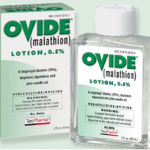- Type of Drug: Scabicide.
- Prescribed for: Head lice.
Malathion General Information
Originally used as an agricultural insecticide, Malathion has been tested and found to be effective against common lice and the eggs they leave behind in the scalp. Malathion works by interfering with the normal breakdown of acetylcholine, a common carrier of nervous-system impulses. The excess acetylcholine produced by Malathion accounts for its toxicity to the lice and eggs.
After it has been applied to the hair, Malathion binds slowly with the hair shaft, providing some protection against future infestations. This binding process, and the protection it carries, takes about 6 hours to develop and reaches its maximum effect in about 12 hours.
Malathion Cautions and Warnings
Malathion is an extremely toxic substance if swallowed (see Overdosage for more information). People with proven Malathion sensitivity should not use this product. Normally about 89 percent of the Malathion applied to your skin is absorbed into the bloodstream, but larger quantities may be absorbed if the lotion is applied to broken skin of open sores. In rare situations, there is a chance of a toxic reaction if too much Malathion is absorbed through your skin into the blood.
Malathion lotion is flammable. Don’t expose the lotion or hair that is still wet with the lotion to an open flame or an electric dryer because of the possibility of fire. Allow hair to dry naturally after application. Malathion can severely damage your eyes. If some of it gets into your eyes, flush them with water immediately.
People with any of the following conditions should be cautious when using Malathion because it can precipitate an attack or worsen your condition: asthma, very slow heartbeat or low blood pressure, stomach spasms or ulcer, recent heart attack, or Parkinson’s disease.
Malathion can worsen the following conditions: severe anemia, dehydration, insecticide exposure effects, liver disease or cirrhosis, malnutrition, myasthenia or other neuromuscular diseases, and seizure disorders.
People with recent brain surgery should be concerned about using this product because it can initiate toxic nervous-system effects, including seizures.
Malathion Possible Side Effects
- Common: scalp irritation. Malathion is extremely toxic if it is swallowed or gets into your eyes (see Overdosage for more information).
- Rare: Convulsions and other drug effects can occur if enough drug is absorbed into the blood through the scalp (see Overdosage for details).
Drug Interactions
No drug interactions have been reported. However, unusually large amounts of Malathion could interact with injectable antibiotics {aminoglycosides) to cause breathing problems, with local anesthetics to interfere with their breakdown and cause systemic side effects, and with some eyedrops used to treat glaucoma (Physostigmine, Echothiophate, Demecarium, and Isoflurophate) to cause side, effects. Consult your doctor or pharmacist for more information.
Food Interactions
None known.
Usual Dose
Adult and Child (age 2 and older): apply to the hair and scalp and repeat after 7 to 9 days, if necessary.
Malathion Overdosage
If swallowed, or absorbed through your skin, Malathion can cause serious problems. Symptoms of Malathion toxicity include abdominal cramps, anxiety, restlessness, clumsiness or unsteadiness, confusion, depression, diarrhea, dizziness, drowsiness, increased sweating, watery eyes or mouth, loss of bowel or bladder control, muscle twitching in the eyelids, face or neck, pinpointed pupils, difficulty breathing, seizures, slow heartbeat, trembling, and weakness.
Malathion overdose is potentially deadly. People who swallow this product may not experience toxic effects for up to 12 hours. However, victims should be made to vomit with Syrup of Ipecac (available at any pharmacy) to remove any remaining drug from the stomach. Anyone who swallows Malathion MUST be taken to a hospital emergency room for treatment. ALWAYS bring the medicine bottle.
If any Malathion gets into your eyes, IMMEDIATELY flush them with water to remove the insecticide and to avoid damage to your vision, then go to a hospital.
Malathion Special Information
Follow your prescription exactly, and do not use this product without your doctor’s approval.
Sprinkle the lotion onto dry hair and rub in until the hair and scalp are wet. Pay special attention to the back of your head and neck. Avoid contact with the eyes. Wash your hands immediately after applying the lotion to remove any remaining Malathion from your skin. Allow the treated hair to dry naturally; do not cover it or use an electric dryer (or other heat source). Do not shampoo the hair and scalp for 8 to 12 hours to allow the medicine to work. After 8 to 12 hours have passed, shampoo with a plain shampoo. Remove the dead lice and eggs from the scalp with a fine-toothed comb.
Pregnant women should not handle this medication or apply it to others.
Other household members also may have lice and require Malathion treatments. Call your doctor for information.
After head lice have been found, be sure to practice good hygiene to prevent spreading the lice and possible reinfestation of the treated scalp. Wash all clothing, bedding, towels, and washcloths in very hot water or dry-clean them to kill any lice or eggs. Hairbrushes or combs used by people with head lice infestation must be washed in very hot, soapy water to remove any remaining lice or eggs. Do not share brushes and combs because they may spread the lice. Thoroughly clean the entire living area, including furniture and clothing, with a vacuum cleaner to remove any remaining lice or eggs.
Be careful to avoid exposure to other insecticides while being treated with Malathion.
Malathion Special Populations
Pregnancy/Breast-feeding
Malathion may be absorbed and can affect a developing fetus. Pregnant women and those who might be pregnant should not use it or apply it to others.
It is not known if Malathion passes into breast milk. There is a chance that some of the insecticide will be absorbed into the bloodstream and possibly passed on to the nursing infant. Nursing mothers should bottle-feed their babies if using this medicine.
Seniors
Seniors may use this product without special restriction.

